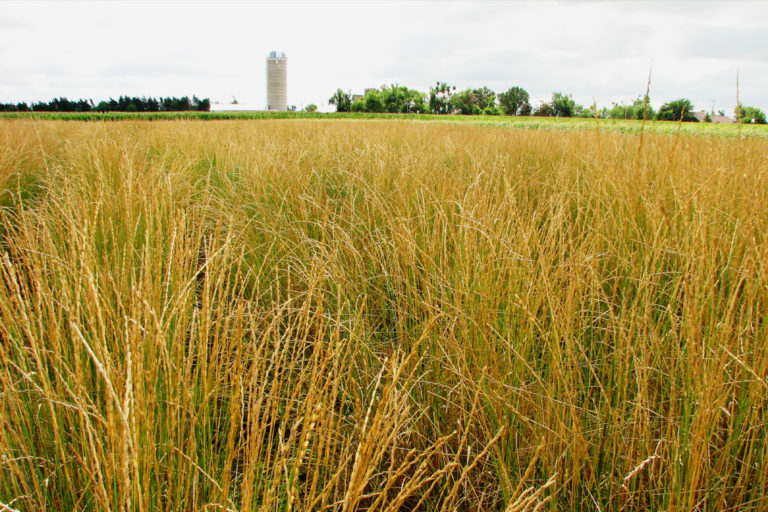- Intermediate wheatgrass is an imported grain that has been grown in the U.S. Great Plains and Intermountain West since the 1930s; but could it be used in marginal fields in dryland areas?
- Kernza, an intermediate wheatgrass bred by the Land Institute, is being planted in eastern Wyoming, where researchers from the University of Wyoming are uncovering whether the crop can help farmers stabilize and bolster their soils, while providing a profitable crop.
- Planting perennial crops, like Kernza, can help soil health and stability, retain moisture, and cut down on planting costs and greenhouse gas emissions from annual plantings.
Farming in eastern Wyoming is not for the faint of heart. The semiarid landscape receives unpredictable weather and is considered an unforgiving environment for agriculture.
Despite this, farmers have grown annual winter wheat crops in eastern Wyoming, but at a cost. Given the harsh growing conditions, farmers note that with falling wheat prices, soil degradation, and variable weather, annual crops feel like a losing proposition.
“Farmers—especially in this region, but across the country—are really looking for things that can give them some resilience in the face of climate change,” said Hannah Rodgers, a soil science doctoral student at the University of Wyoming.
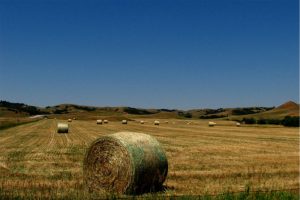
Wheat farm in Wyoming. Despite the semiarid landscape and unpredictable weather, farmers have grown annual winter wheat crops in eastern Wyoming. Image by CGP Grey via Flickr (CC BY 2.0).
To encourage farmers to keep fields flourishing, conservationists are suggesting a new approach: plant a new perennial grain called Kernza. This novel grain was developed by the Land Institute, a Kansas-based organization, as a way for farmers to boost the health of their soils while providing a more profitable crop.
Researchers at the University of Wyoming, including Rodgers, were awarded a $75,000 Western Sustainable Agriculture Research and Education grant to study the feasibility of Kernza in the dry Wyoming fields.
A cousin to wheat
Kernza is also known as intermediate wheatgrass (Thinopyrum intermedium), a perennial grass that was introduced to the United States in the 1930s from Europe and Western Asia. Used primarily for hay, forage and pasture lands, it has become a favorite conservation grass in the Great Plains and Intermountain West, as it does best at elevations between about 1,100 and 2,700 meters (3,500 and 9,000 feet). The root systems are deep and robust, making it a great soil-stabilizing plant.
Since 1988, researchers at the Land Institute have been breeding intermediate wheatgrass to improve yield, seed size and disease resistance. The resulting plant, now trademarked, is a perennial grain that has the potential to produce a profitable crop while bringing numerous environmental benefits to farmers.
“It’s like a cousin to wheat,” said Alex Fox, an ecophysiology doctoral student at the University of Wyoming who is also involved with the study. The grains are smaller than with traditional wheat, but the taste is similar, albeit a tad nuttier. The grain is lower in gluten than annual wheat, and Fox noted that “it acts similarly to rye flour when you’re baking.”
Kernza has already been adopted by millers, bakers, and brewers for use in cereals, bread and beer.
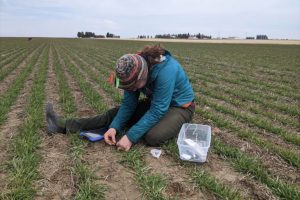
Hannah Rodgers, doctoral researcher at University of Wyoming, sits in a field of wheat, to measure how the plants fluoresce. The measurements can tell the team how the plants deal with water stress. These data will be used to compare the adaptation of wheat versus Kernza in Wyoming. Image courtesy of Alex Fox.
Although scientists have been developing Kernza for decades, field testing is relatively new. “It’s only in maybe its fifth year of production agriculture,” Rodgers said. She added that while most plantings have been in Midwestern states, this experiment is the first to try planting in dryland fields—what she calls the “limit of what you can farm.”
“The way dryland agriculture works here [in eastern Wyoming] is you might only get one crop of wheat every two or three years,” Fox said. “Because there is so little water, a lot of the farmland is just left fallow for years.”
Fallow land is ripe for erosion issues, compounding soil degradation in the fields. All these challenges lead to low yields of annual crops, which can cause famers to throw in the towel and abandon their fields.
As a perennial plant, Kernza produces deep root systems that hold soil in place and prevent erosion. Vicki Morrone, an organic farming specialist at Michigan State University, who was not involved in the study, said the roots ofperennial grains like Kernza are phenomenal.
“We’ve done pits … in the field and we found root hairs as deep as 25 to 30 feet [8 to 9 m],” she said, adding, “it’s beautiful.”
Morrone added that in terms of the environmental service performed — holding water, reducing leaching, and reducing erosion — perennial wheatgrass is excellent.
The robust roots also sequester carbon while they reach deep into the soil to access water and nutrients. And because Kernza will come back year after year, farmers save money on replanting and curb fossil fuel emissions by eliminating annual plantings.
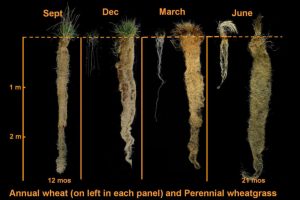
The root systems in an annual wheat, on the left in each panel, and perennial wheatgrass. Perennial crops establish deep and fibrous root systems compared to their annual cousins. Image by Dehaan via Wikimedia Commons (CC BY 3.0).
A testing ground for Kernza
The researchers are now testing Kernza at four different locations in Wyoming: three farms and land on a research station. The team will compare the soil characteristics in Kernza fields to natural prairie (healthy, thriving soils) and those planted with annual grains (soils that are in poorer health), to note what the intermediate wheatgrass might bring to dryland fields.
The researchers will examine soil health in the fields, including organic carbon, nutrients, and microbial communities. They will also survey water storage, resistance to erosion, and overall productivity of the fields, as well as external inputs like rain and fertilizers.
“From an agronomy soil health perspective, we’re feeling pretty confident that [Kerzna] is going to help soil health just because it is a perennial,” Rodgers said. But she noted that the unknown parameter is yield.
In the best of growing conditions, Kernza grains are smaller than wheat, and yields have been about a third of traditional wheat. “In a lot wetter climates, it can be really hard to get Kernza to be economically competitive with some other crops,” Fox noted. But the very thing that makes farming so challenging in eastern Wyoming might be the thing that could make Kernza a viable solution.
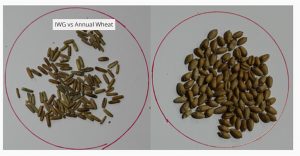
Intermediate wheatgrass seed, left, is considerably smaller than annual wheat grains. Image courtesy of Vicki Morrone.
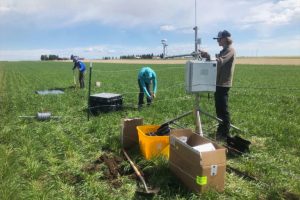
Researchers from the University of Wyoming set up a meteorological station and soil pits in a wheat field. They are collecting data on the natural rainfall in the region, as well as information about the soil health on annually-planted fields. They will repeat the measurements in established Kernza fields as the experiment progresses. Image courtesy of Hannah Rodgers.
“The reason that we think Kernza is great for this environment is that we have such unpredictable rainfall,” Rodgers said. “So, for example … if we had a drought year, and there was no harvestable seed, farmers are used to that.” The benefit of Kernza is that the crop could survive that year, and hopefully thrive in a wetter season. Farmers would save on planting costs, the fields wouldn’t be left bare, and the soil would remain protected.
Morrone noted that profitability of Kernza in Wyoming is tricky. She said farmers can expect yields from Kernza to be a third of what annual wheat would produce. And that’s when growing occurs in ideal conditions. But the dry weather of Wyoming could further impact yields.
She added that growing Kernza in eastern Wyoming is “truly a novelty crop.” But Morrone also said it has the potential to be a great fit for the region, “either for grain for flour or even beer, as well as animal feed” when used as an extended-season pasture crop.
At the end of the experiment, the researchers at the University of Wyoming say they hope to have a better idea of the viability of Kernza for dryland ecosystems. Rodgers noted that the team doesn’t expect to see yields like those in wetter climates, but that even low yields would make Kernza a competitive crop for the region.
“And on top of that, it’s building soil health, it’s building long-term fertility, it’s lowering your input costs, it’s using less fossil fuels,” she added. “All those other great things are happening.”
Source: Mongabay
To view source article, visit:
Organic & Non-GMO Insights October 2021

